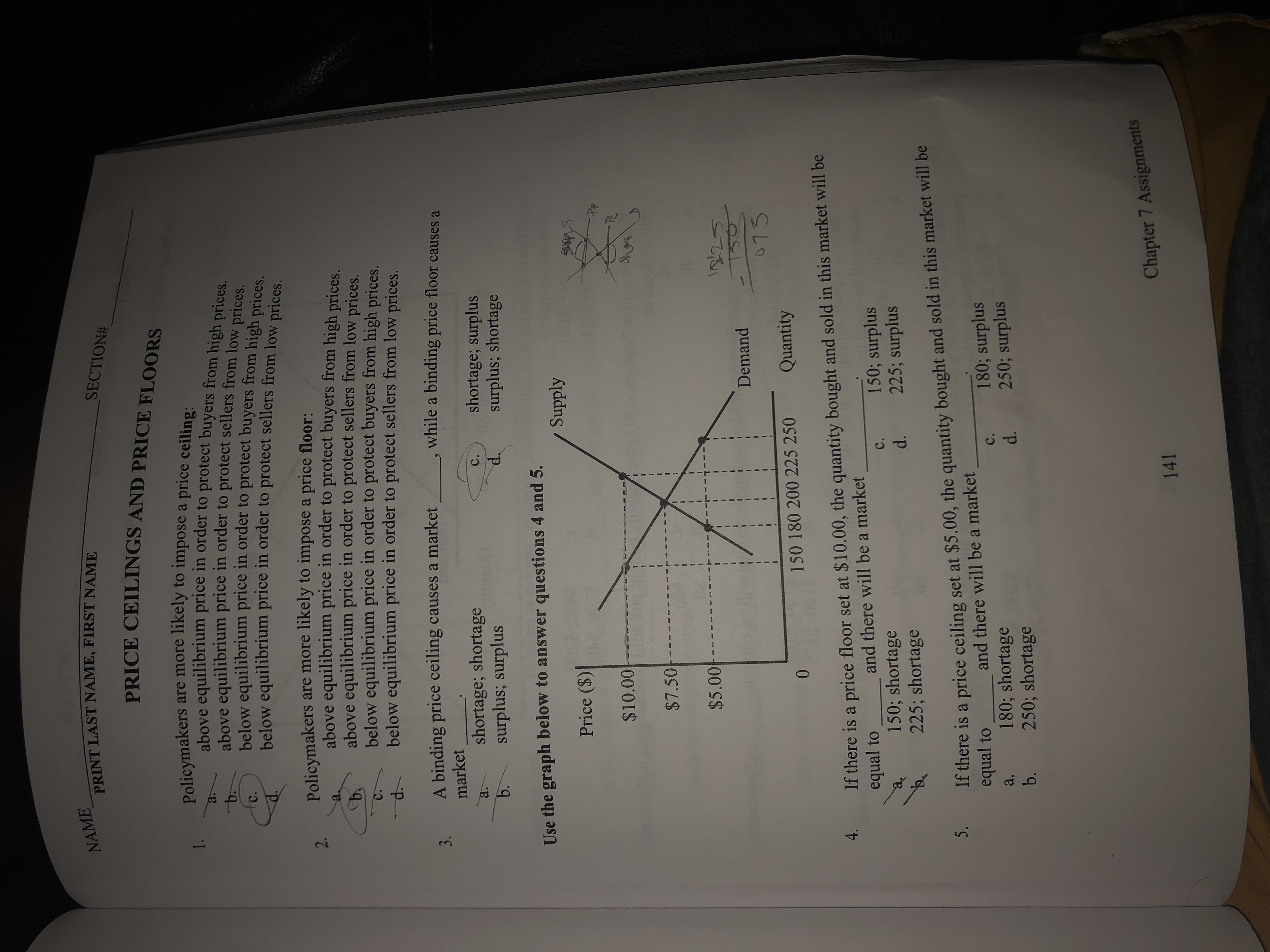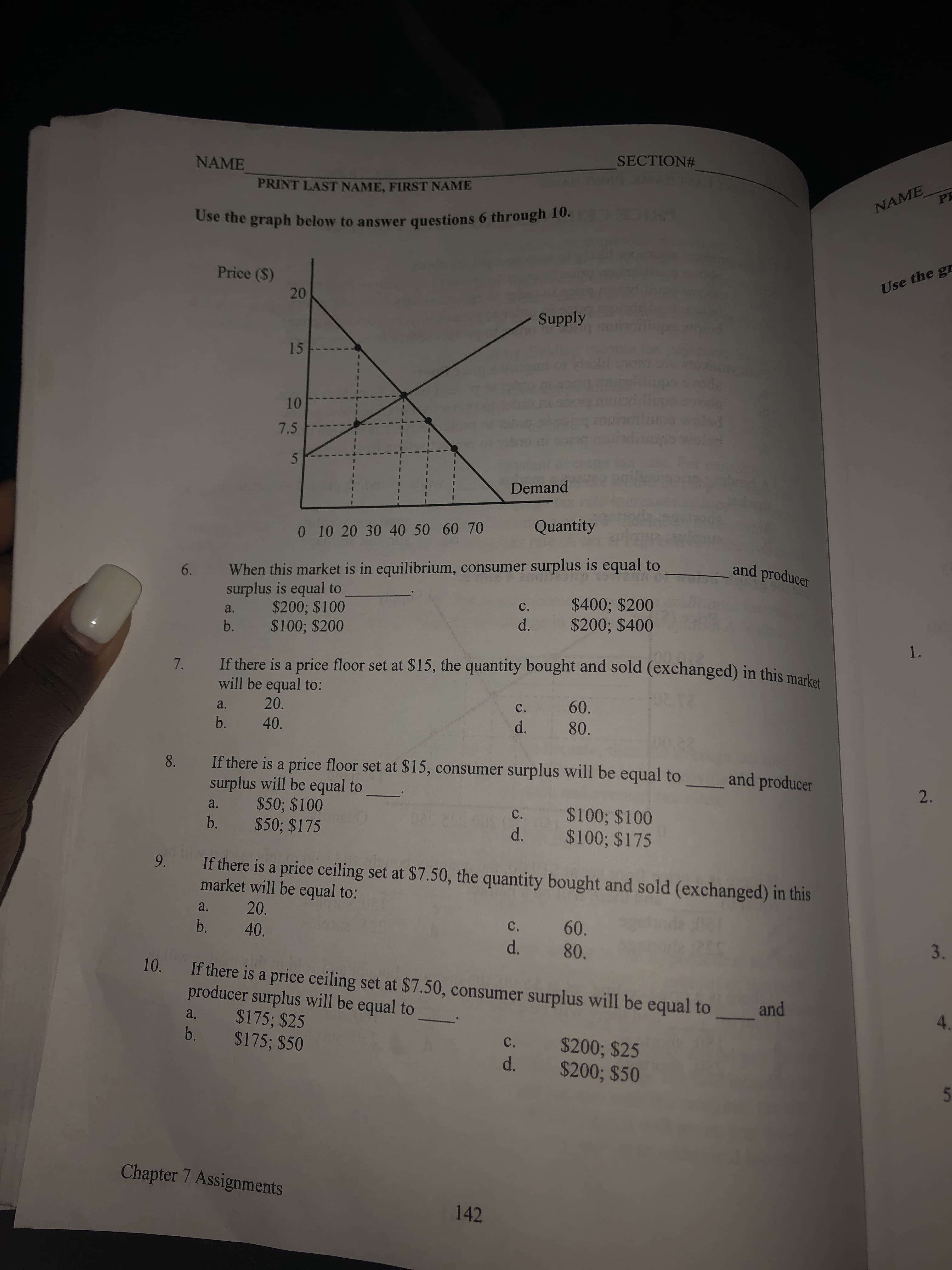NAME PRINT LAST NAME, FIRST NAME SECTION# PRICE CEILINGS AND PRICE FLOORS Policymakers are more likely to impose a price ceiling- above equilibrium price in order to protect buyers from high prices. above equilibrium price in order to protect sellers from low prices. below equilibrium price in order to protect buyers from high prices 1. b. C. below equilibrium price in order to protect sellers from low prices. Policymakers are more likely to impose a price floor: above equilibrium price in order to protect buyers from high prices. above equilibrium price in order to protect sellers from low prices. below equilibrium price in order to protect buyers from high prices. below equilibrium price in order to protect sellers from low prices. 2. a. C. 3. A binding price ceiling causes a market while a binding price floor causes a market shortage; shortage surplus; surplus b. shortage; surplus surplus; shortage C. Use the graph below to answer questions 4 and 5. Supply Price ($) $10.00 $7.50 0000 150 073 Demand 150 180 200 225 250 Quantity 0. If there is a price floor set at $10.00, the quantity bought and sold in this market will be equal to and there will be a market c. 150; shortage 225; shortage 150; surplus 225; surplus d. 3. If there is a price ceiling set at $5.00, the quantity bought and sold in this market will be equal to and there will be a market 180; surplus 250; surplus d. c. 180; shortage 250; shortage a. b. Chapter 7 Assignments 141 SECTION# NAME PRINT LAST NAME, FIRST NAME NAME PE Use the graph below to answer questions 6 through 10. Price (S) Use the gr - Supply 15 10 7.5 Demand Quantity 0 10 20 30 40 50 60 70 When this market is in equilibrium, consumer surplus is equal to surplus is equal to $200; $100 $100; $200 and producer 6. $400; $200 $200; $400 C. a. d. b. 1. If there is a price floor set at $15, the quantity bought and sold (exchanged) in this meala will be equal to: 7. 20. a. 60. C. b. 40. d. 80. If there is a price floor set at $15, consumer surplus will be equal to surplus will be equal to $50; $100 $50; $175 and producer a. $100; $100 $100; $175 C. b. d. If there is a price ceiling set at $7.50, the quantity bought and sold (exchanged) in this market will be equal to: 9. 20. a. b. 60. C. 40. d. 80. 3. 10. If there is a price ceiling set at $7.50, consumer surplus will be equal to producer surplus will be equal to $175; $25 b. $175; $50 and a. $200; $25 $200; $50 c. d. Chapter 7 Assignments 142 2. 20 8.
NAME PRINT LAST NAME, FIRST NAME SECTION# PRICE CEILINGS AND PRICE FLOORS Policymakers are more likely to impose a price ceiling- above equilibrium price in order to protect buyers from high prices. above equilibrium price in order to protect sellers from low prices. below equilibrium price in order to protect buyers from high prices 1. b. C. below equilibrium price in order to protect sellers from low prices. Policymakers are more likely to impose a price floor: above equilibrium price in order to protect buyers from high prices. above equilibrium price in order to protect sellers from low prices. below equilibrium price in order to protect buyers from high prices. below equilibrium price in order to protect sellers from low prices. 2. a. C. 3. A binding price ceiling causes a market while a binding price floor causes a market shortage; shortage surplus; surplus b. shortage; surplus surplus; shortage C. Use the graph below to answer questions 4 and 5. Supply Price ($) $10.00 $7.50 0000 150 073 Demand 150 180 200 225 250 Quantity 0. If there is a price floor set at $10.00, the quantity bought and sold in this market will be equal to and there will be a market c. 150; shortage 225; shortage 150; surplus 225; surplus d. 3. If there is a price ceiling set at $5.00, the quantity bought and sold in this market will be equal to and there will be a market 180; surplus 250; surplus d. c. 180; shortage 250; shortage a. b. Chapter 7 Assignments 141 SECTION# NAME PRINT LAST NAME, FIRST NAME NAME PE Use the graph below to answer questions 6 through 10. Price (S) Use the gr - Supply 15 10 7.5 Demand Quantity 0 10 20 30 40 50 60 70 When this market is in equilibrium, consumer surplus is equal to surplus is equal to $200; $100 $100; $200 and producer 6. $400; $200 $200; $400 C. a. d. b. 1. If there is a price floor set at $15, the quantity bought and sold (exchanged) in this meala will be equal to: 7. 20. a. 60. C. b. 40. d. 80. If there is a price floor set at $15, consumer surplus will be equal to surplus will be equal to $50; $100 $50; $175 and producer a. $100; $100 $100; $175 C. b. d. If there is a price ceiling set at $7.50, the quantity bought and sold (exchanged) in this market will be equal to: 9. 20. a. b. 60. C. 40. d. 80. 3. 10. If there is a price ceiling set at $7.50, consumer surplus will be equal to producer surplus will be equal to $175; $25 b. $175; $50 and a. $200; $25 $200; $50 c. d. Chapter 7 Assignments 142 2. 20 8.
Chapter4: Markets In Action
Section: Chapter Questions
Problem 13SQ
Related questions
Question

Transcribed Image Text:NAME
PRINT LAST NAME, FIRST NAME
SECTION#
PRICE CEILINGS AND PRICE FLOORS
Policymakers are more likely to impose a price ceiling-
above equilibrium price in order to protect buyers from high prices.
above equilibrium price in order to protect sellers from low prices.
below equilibrium price in order to protect buyers from high prices
1.
b.
C.
below equilibrium
price in order to protect sellers from low
prices.
Policymakers are more likely to impose a price floor:
above equilibrium price in order to protect buyers from high prices.
above equilibrium price in order to protect sellers from low prices.
below equilibrium price in order to protect buyers from high prices.
below equilibrium price in order to protect sellers from low prices.
2.
a.
C.
3. A binding price ceiling causes a market
while a binding price floor causes a
market
shortage; shortage
surplus; surplus
b.
shortage; surplus
surplus; shortage
C.
Use the graph below to answer questions 4 and 5.
Supply
Price ($)
$10.00
$7.50
0000
150
073
Demand
150 180 200 225 250
Quantity
0.
If there is a price floor set at $10.00, the quantity bought and sold in this market will be
equal to
and there will be a market
c.
150; shortage
225; shortage
150; surplus
225; surplus
d.
3. If there is a price ceiling set at $5.00, the quantity bought and sold in this market will be
equal to
and there will be a market
180; surplus
250; surplus
d.
c.
180; shortage
250; shortage
a.
b.
Chapter 7 Assignments
141

Transcribed Image Text:SECTION#
NAME
PRINT LAST NAME, FIRST NAME
NAME
PE
Use the graph below to answer questions 6 through 10.
Price (S)
Use the gr
- Supply
15
10
7.5
Demand
Quantity
0 10 20 30 40 50 60 70
When this market is in equilibrium, consumer surplus is equal to
surplus is equal to
$200; $100
$100; $200
and producer
6.
$400; $200
$200; $400
C.
a.
d.
b.
1.
If there is a price floor set at $15, the quantity bought and sold (exchanged) in this meala
will be equal to:
7.
20.
a.
60.
C.
b.
40.
d.
80.
If there is a price floor set at $15, consumer surplus will be equal to
surplus will be equal to
$50; $100
$50; $175
and producer
a.
$100; $100
$100; $175
C.
b.
d.
If there is a price ceiling set at $7.50, the quantity bought and sold (exchanged) in this
market will be equal to:
9.
20.
a.
b.
60.
C.
40.
d.
80.
3.
10. If there is a price ceiling set at $7.50, consumer surplus will be equal to
producer surplus will be equal to
$175; $25
b. $175; $50
and
a.
$200; $25
$200; $50
c.
d.
Chapter 7 Assignments
142
2.
20
8.
Expert Solution
This question has been solved!
Explore an expertly crafted, step-by-step solution for a thorough understanding of key concepts.
This is a popular solution!
Trending now
This is a popular solution!
Step by step
Solved in 2 steps

Recommended textbooks for you






